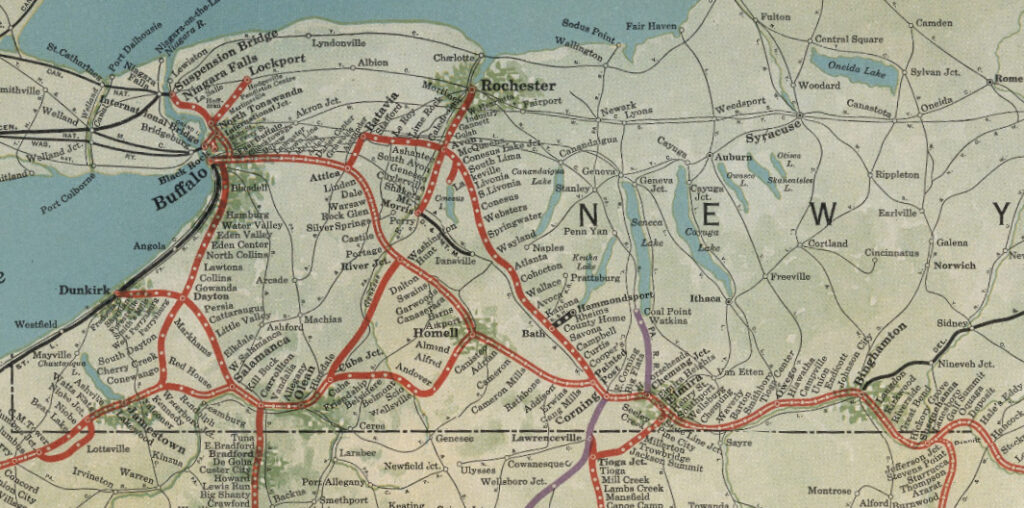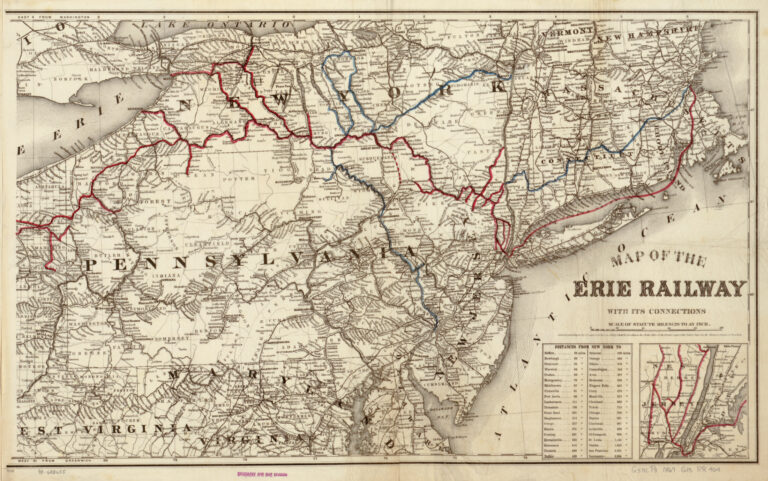
History
The New York and Erie Railroad was chartered in April 1832 to go from the banks of the Hudson River to the shores of Lake Erie, with the restriction that it could not enter any other state or connect with railroads from other states. This line was completed in 1851 between Piermont and Dunkirk via Little Valley, Cattaraugus and Dayton. The route of the line through Cattaraugus and Chautauqua counties was subject to much debate and lobbying and is an interesting story in its own right.
At Salamanca, the railroad connected with the Atlantic and Great Western Railway, another broad-gauge line that was completed between Salamanca and Jamestown in 1860. The Erie had a complicated relationship with the A&GW. The Erie first leased the A&GW in December 1868, forced the A&GW into receivership, leased it again in March 1870 until the A&GW was foreclosed in 1871. In 1874 the Erie again leased the A&GW, but later canceled it. The A&GW was sold at foreclosure and reorganized as the New York, Pennsylvania & Ohio Railroad, or Nypano. In 1883 the Erie leased the Nypano and on February 24, 1896 purchased the entire capital stock of the company. In 1941 the property of the Nypano Railroad Company was conveyed to the Erie. The A&GW/Nypano was the Erie’s link to the west and the cities of Cleveland, Cincinnati and Chicago.
Realizing that it may have made a mistake in placing its Lake Erie terminus at Dunkirk instead of Buffalo, the Erie reached Buffalo in 1863 by leasing the Buffalo, New York and Erie Railroad Company for 450 years. In 1872 the Erie reached Buffalo from the south via the Buffalo & Southwestern Railroad from Jamestown to Buffalo. This line connected with the main line at Dayton, NY.
In 1905 the Erie chartered the Columbus and Erie Railroad to build a low-grade line on the Meadville line between Niobe, NY and Columbus, PA.
The Erie went through a number of name changes in its history. As noted above, the company was chartered in 1831 as the New York and Erie Railroad. In 1861 it changed its name to the Erie Railway. On April 24, 1875 the bankrupt Erie Railway was sold for six million dollars and the entire property was transferred to the New York, Lake Erie and Western Railroad. In May 1893 the NYLE&W went into bankruptcy again and was reorganized in 1895 as the Erie Railroad Company.
The Erie was built as a broad-gauge line, having 6 feet between the rail as opposed to the standard 4 feet 8 1/2 inches. This enabled the Erie to carry wider and larger items than its standard-gauge competitors, but made it difficult to interchange with them. In 1880 the entire mainline of the Erie was converted to standard-gauge in a single day.
The Erie Railroad operated from 1895 until 1960 when it merged with the Delaware, Lackawanna and Western Railroad to form the Erie Lackawanna Railroad.
The actual corporate history of the Erie Railroad is more complex than covered above and includes a number of “paper railroads” that were chartered and raised money but who did not lay any track or operate any trains. I didn’t include the in this summary, though there is a discussion of some them in the pages for the specific railroads. For those that are interested in the details, please see the Erie Railroad Corporate History page.
Lines and Stations
- Attica Branch – Avon to Attica
- Rochester Line – Rochester to Corning
- Buffalo Line – Hornell to Buffalo
- River Line – River Junction to CB Junction
- Original Main Line – Binghamton to Dunkirk
- Meadville Line – Salamanca to PA State Line
- Buffalo and Southwestern Branch – Buffalo to Jamestown
- Niagara Falls and Lockport Branches – Buffalo to Suspension Bridge and Lockport
- Mount Morris Branch – Avon to Mount Morris
Clippings
Maps
Timetables
- August 1893 timetable (PDF)
- April 29, 1934 Erie System Timetable (xw4.org)
- September 28, 1941 System Timetable (wx4.org)
- September 16, 1943 Erie System Timetable (xw4.org)
- March 11, 1945 Erie System Timetable (xw4.org)
- August 5, 1945 Erie System Timetable (xw4.org)
- February 17, 1946 Erie System Timetable (xw4.org)
- June 16, 1946 Erie System Timetable (xw4.org)
- January 2, 1951 System Timetable (wx4.org)
- January 11, 1954 Erie System Timetable (xw4.org)
- October 28, 1956 Erie System Timetable (xw4.org)
- April 28, 1957 Erie System Timetable (xw4.org)
- October 27, 1957 Erie System Timetable (xw4.org)
- January 26, 1958 Erie System Timetable (xw4.org)
- April 27, 1958 Erie System Timetable (xw4.org)
- October 26, 1958 Erie System Timetable (xw4.org)
- January 17, 1959 Erie System Timetable (xw4.org)
- October 25, 1959 Erie System Timetable (xw4.org)
- April 24, 1960 Erie System Timetable (xw4.org)
Documents
Learn More
Listed below are some other good sources of information about the railroad.
- Adam, Charles F. and Adams, Henry. 1871. Chapters of Erie, and Other Essays
- Carleton, Paul. 1988. The Erie Railroad Story.
- Crouch, Geo. 1869. Another Chapter of Erie.
- Erie Lackawanna Railroad Historical Society
- Erie Railway. 1874. The Erie Railway Tourist. An 1874 advertising book touting the many sights along the Erie Railway.
- Hungerford, Edward. 1949. Men of Erie. New York, NY: Random House
- Kilmer, Lawrence. date unknown. Erie Railroad Bradford Branch. Olean, NY: Lawrence J. Kilmer.
- Lord, Eleazar. 1855. A historical review of the New York and Erie railroad. An 1855 book by one of the early presidents of the company.
- Minor, George H. 1911. The Erie System – A Statement of various facts relating to the Organization and Corporate History.
- Mott, Edward Harold. 1899. Between the Ocean and the Lakes: The Story of Erie.
- New York, Lake Erie & Western Railway. 1887. The Erie Route: A Guide of the New York, Lake Erie & Western Railway and its Branches. An 1887 guidebook that covers the entire line.
- Westing, Frederick. 1970. Erie Power. Medina, OH: Alvin F. Staufer.
- Wikipedia. “Erie Railroad“

